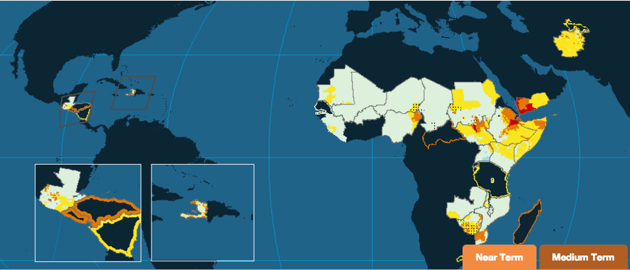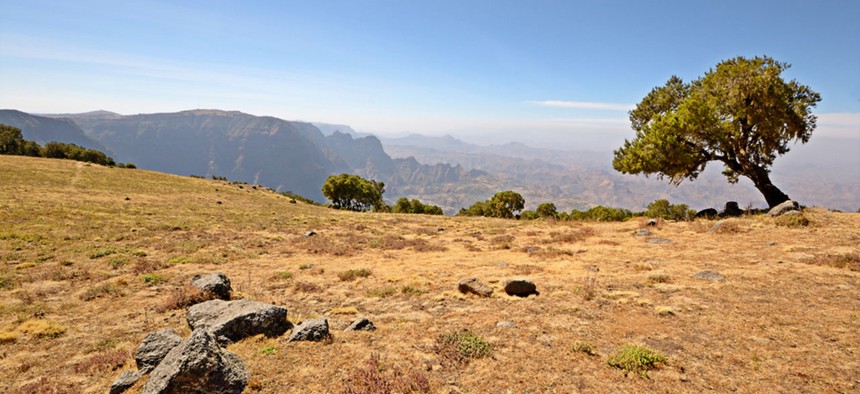The U.S. Predicted the Ethiopian Food Crisis Months Ago
A USAID program can predict food insecurity before it occurs. But the warnings aren’t always heeded.
Thanks to El Niño, some parts of Ethiopia are currently facing the worst drought in 30 years. More than 10 million people in the country will likely need food aid this year. Over the weekend, UN Secretary General Ban Ki-moon implored the world to attend to this, one of its lesser-recognized ongoing humanitarian crises.
He made an unusual pitch.
“We face unrelenting humanitarian needs around the world. Many are generated by conflict and displacement. These human-made crises are extremely difficult to resolve and can last for years or even decades,” said Ban.
But the emergency in Ethiopia was different, he said: “We know it will pass, and the situation will improve. This crisis will end.”
This made providing help now especially important, he said.
Many experts are worried that 2016 will be an unusually bad year for hunger around the world. El Niño brings pleasant if disconcertingly warm weather to North America, but its consequences elsewhere in the world can be far more devastating. In addition to eastern Africa, rains have so far failed or faltered this year in Central America, parts of the Caribbean, and southern Africa.
Not only are hunger crises usually temporary, as Ban notes, but they also differ from wars or mass-migrations in other ways. Hunger happens slowly. Droughts develop across months, as one rainless day follows another. Then, as local markets skitter to a halt and shut down, food insecurity and even famine can arrive.
This lack of speed makes it relatively easy to predict hunger. And, accordingly, the Ethiopian emergency was well forecast. As a climate reporter, I’ve heard fretting about the situation in the Horn of Africa since at least October. That was when I began to wonder: How do you know when a famine is coming?
* * *
For almost a year, U.S. officials have warned that food could become scarce in regions of the Horn of Africa. These warnings came in the form of the Famine Early Warning Systems Network, a USAID program usually shortened to FEWSNET. With rationalist clarity, FEWSNET classifies the food security situation in 36 of the world’s countries:

FEWSNET categorizes each country, and some provinces and regions, according to a five-scale food-security scale. Most areas have “none to minimal” food-security problems. The scale elevates after that: Some areas will experience a “stressed” food-security situation, which becomes a food-security “crisis,” then a food-security “emergency” and, eventually, a “famine.” (I’m putting quotes around certain terms only because they are technical terms within the scale.)
FEWSNET also regularly puts out forecasts for regions, detailing why it’s forecasting certain food situations for certain regions and why. While FEWSNET has been going on for more than 30 years, it can seem hyper-rational to the point of being algorithmic. Put a lot of numbers about a faraway place into a super computer, pop down to the corner Starbucks, and come back in time to watch it spit out a prediction.
The reality is both much more involved and much less mathematical.
“It is not a computer program, it is not a quantitative modeling process,” says Chris Hillbruner, a senior advisor at FEWSNET. “There really isn’t a mathematical formula that lets you calculate where food security is going. There’s not even a mathematical formula to calculate what current food security is.”
Nor, says Hillbrunner, is there any easy way to check on hunger levels in a region. “There is no gold standard food-security indicator,” he told me.
So even though FEWSNET looks algorithmic, it’s not. To arrive at their classifications, the program’s experts meet in one place and consult a lot of information. This information encompasses data from local markets, weather and climactic reports; and data on local livelihoods, nutritional reports, and what kind of humanitarian assistance is already being provided. It includes information as specific as intra-provincial requests for local water-truck usage and documentation of recent crop diseases.
Most of this data isn’t scraped from the Internet. Employees in the field collect the bulk of FEWSNET’s data in person. More than 300 FEWSNET employees work full-time in the 36 presence countries that it follows, collecting information on the ground and advising its central office.
If FEWSNET is an impressive part of the modern world, it’s not because of its unmatched computer power or impressive mathematical rigor. It’s because the entire program is filled with people, touching and handling and creating the data at every step along the way. Yet this data remains clinical: There’s a dissonance between FEWSNET’s clean color-classification system and the devastating upheaval of lived food-insecurity.
Hillbrunner said he doesn’t expect Ethiopia to enter famine-stage during this crisis. The worst things may get, he said, is stage four. I asked him to describe what stages three and four meant for families on the ground.
He described a “two-basket” system that FEWSNET looks at when it makes its estimate. The first is a basket that includes the costs of survival: food, water, and shelter. The second encompasses investments a family needs to make to continue its livelihood. These include school fees, buying seeds, and feeding cattle.
“A household that’s in crisis means one of two things. They’re having great difficulty and they’re unable to pay these key expenditures that make up the livelihood protection basket,” he said. “And then either they’re starting to face food deficits—meaning they also don’t have enough money to buy the food they need—or they can afford the food but only because they’re using really negative strategies. They can’t buy livestock, or they’re pulling their kids out of school.”
“When you have an area in level three, this is when we would anticipate starting to see an increase in the prevalence of malnutrition among children,” he said.
“In Phase Four, households can’t afford non-food expenditures, and they’re also starting to face much larger food-consumption gaps. Even employing whatever coping strategies, they’re still at a significant shortfall in their ability to meet whatever food they need for survival. This is associated with very high levels of malnutrition, and then Phase Four is also where we start to see an increase in mortality, particularly among children,” he said.
Which is to say that even when there is not a technical famine, a food-insecurity emergency can be catastrophic. Civil-society groups such as Oxfam, despite being underfunded for the current crisis, have already begun responding. Throughout Ethiopia in particular, they have distributed water, cash, and occasionally food. (Since food insecurity is more about food being too expensive, versus it being unavailable, cash transfers allow local economies to continue functioning until food prices fall.)
A perk of early-warning systems like FEWSNET, too, is that civil groups can prepare for crises before they happen, and position food and water nearby ahead of time. That’s especially important in years like this one, when the world’s humanitarian-response infrastructure will be extremely stretched.
“We expect that 2016 is going to be a very difficult year with atypical levels of food security in a variety of areas,” Hillbruner told me. FEWSNET sees two different types of crises leading to such dire need.
First, there have been ongoing food emergencies for sometime in Yemen, South Sudan, and the northeast region of Nigeria. These three crises taken together have spelled emergency levels of hunger for about 11 million people.
The second issue facing humanitarian groups is El Niño. “We’re in the middle of a very strong El Niño, one of the three strongest since the 1950s,” he told me. Its many consequences cascade around the world, including in Ethiopia.
FEWSNET predicted Ethiopia’s current crisis roughly a year ago—though it has continued scaling up the estimate of the emergency since. In February 2015, experts thought 2.9 million people would require food assistance. By August, 4.5 million were anticipated to need help; two months later, the number rose again to 8.2 million.
Now, the U.S. estimates at least 10 million people will likely receive food assistance before the emergency ends. That figure is on top of the 7 million people already supported by the Ethiopian government’s domestic food-assistance program. At the same meeting as Ban Ki-moon made his address, the United States pledged an additional $97 million in emergency aid on Sunday.
FEWSNET’s current estimate is that about 40 million people will need emergency food assistance in 2016, a 30 percent increase from 2015 totals.
* * *
Despite the efficacy of early-warning systems, politics can thwart them. Five years ago, many experts who pay attention to food scarcity around the world started saying alarming things about the Horn of Africa. Due to a La Niña current in the Pacific, they said, one rainy season after another in the region was failing. Food in the area was getting more and more expensive, and more and more scarce.
In August 2010, FEWSNET issued a report saying that the summer rains had failed to appear in the region. FEWSNET expected food to become more scarce, especially in Somalia. It did, and again in December, FEWSNET warned that it expected “increased mortality” in the region because of the droughts. The death toll began to rise. Finally, in March 2011, another FEWSNET report said that if the spring rains failed, areas of Somalia were destined for famine.
Mortality spiked in May of that year. Unlike a food-insecurity emergency, which can be declared ahead of time, a famine declaration requires evidence that many people have already died. Famines are only declared retrospectively. It was the first time a famine had been declared while the crisis was still in-progress.
Why was the famine not stopped? Thanks to the local militant group Al-Shabaab—and U.S. laws preventing humanitarian groups from interacting with it—food did not reach many areas of Somalia in time or at all.
But the large governments that fund humanitarian groups also did not respond fast enough to other areas in crisis, even if they were not at famine-stage. Both Oxfam and the British government have said that “a dangerous delay”characterized developed-nation responses to the early-warning systems. Aid didn’t reach Somalia thanks to Al-Shabaab—but it didn’t get to regions of Ethiopia, Kenya, and Djibouti because FEWSNET wasn’t heeded.
Despite awareness that a famine was coming, 260,000 people in the region—half of them children—died.
* * *
Are there other ways to detect and respond to food insecurity?
Nine African nations, though not Ethiopia, have pioneered a program calledAfrican Risk Capacity (ARC) through the African Union. ARC is an early-warning system for drought tied to an insurance company. If the early-warning goes off, then the insurance fund disburses.
“The mandate of ARC is to improve the way we respond to current, predictable disasters that members face, especially when it comes to food security, drought, flood, etc.,” said Joanna Syroka, the director of research at ARC.
These kinds of disasters have a certain pattern, she said: “We know they happen, we know they’ll happen again, and they’re very evident when they’re happening.”
ARC differed even from other sovereign insurance programs, she said, because they “care what happens to the money.”
“You need a plan, you need a contingency plan. When you’re acting early and you have money, what am I going to do with that money to make sure it reaches people?,” she said. “We’re not talking about [famine]. We’re talking about, just as the rains fail, just as the drought is coming in, responding to people then, as early as possible, before they start selling their productive assets, before they start pulling their kids out of school or skipping meals.”
Ethiopia is not part of ARC and has its own crop-insurance programs; even without historic drought, that program will support millions of people per year. But ARC hints at other ways that early-warning systems can work. FEWSNET is one of the oldest early-warning systems running. Others now exist for different kinds of disaster: The United States Holocaust Memorial Museum runs an alert system for genocide and other mass atrocities, for instance.
As more and more programs claim to do the same, we will recognize that stopping disaster requires more than detecting it ahead of time. If anything, detecting it ahead of time is easy. Even with perfect knowledge, those with the power to intervene must decide whether it is worth it to act. It is a decision, especially in non-military situations, that we in the rich world have not practiced.
(Image via Fabio Lamanna/Shutterstock.com)








